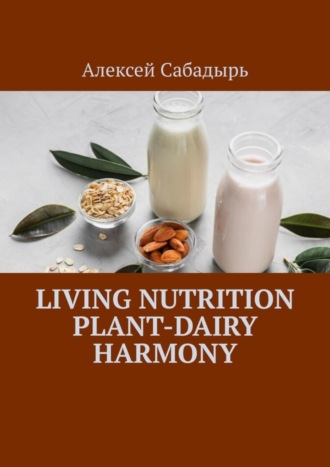
Полная версия
Living Nutrition Plant-Dairy Harmony

Living Nutrition Plant-Dairy Harmony
Алексей Сабадырь
Cover designer Leonardo ai
© Алексей Сабадырь, 2025
© Leonardo ai, cover design, 2025
ISBN 978-5-0062-2336-3
Created with Ridero smart publishing system
Chapter 1: Introduction to the Plant-Dairy Diet: Basic Principles and Benefits
In recent decades, a plant-based diet has become increasingly popular among people seeking a healthier lifestyle. This diet is based on the consumption of plant foods such as fruits, vegetables, grains, legumes, nuts, and dairy products such as milk, yogurt, and cheese. A plant-based dairy diet offers many health, environmental and animal welfare benefits.
In this book, we’ll explore the basic principles of a plant-based diet, discuss its benefits, and help you figure out how to incorporate it into your lifestyle.
Stages of development of a plant-dairy diet
The plant-based dairy diet has ancient roots and reaches deep into the history of various cultures. In different eras and in different parts of the world, people have followed a diet based on plants and dairy products. However, with the advancement of science and research, we have begun to understand the deeper aspects of this way of eating.
Basic principles of a plant-dairy diet
The basis of a plant-based diet is to eat foods that are rich in plant fiber, vitamins, minerals and antioxidants. It can be found in foods such as fruits, vegetables, nuts, seeds, grains and dairy products. Avoiding animal products in favor of plant-based alternatives helps reduce your intake of saturated fat, cholesterol and animal protein.
Benefits of a plant-based dairy diet
A plant-based diet offers many health benefits, including reduced risk of heart disease, diabetes, obesity, and improved immunity and overall energy levels. It also helps improve environmental sustainability and reduce harm to animals.
In this book, we will also look at real success stories of people who have switched to a plant-based diet and discuss the most common mistakes to avoid when switching to this way of eating.
A plant-based diet can be your key to health, sustainability and harmony with nature. Let’s explore this exciting path to a healthy lifestyle together!
Chapter 2: Food Variety: Which Foods to Eat in Your Diet
When it comes to eating healthy, variety is key. Variety not only helps you get all the nutrients you need, but it also makes eating more interesting and tasty. In this chapter, we’ll look at what foods you should add to your diet to give your body everything it needs for health and energy.
Fruits and vegetables are the basis of a healthy diet. They are rich in vitamins, minerals and antioxidants that help support immunity, improve digestion and overall health. A variety of fruits and vegetables is important because each type contains a different set of nutrients. Bright and saturated colors signal the presence of various beneficial substances, so try to include as many colorful foods as possible in your diet.
Proteins are the basis for the construction and repair of muscles, cells and tissues. Animal and plant sources of protein have different amino acid contents, so it is important to combine them in your diet. Meat, fish, eggs, dairy products, tofu, beans, nuts and seeds are just a few of the foods available that can be used to prepare protein-rich meals.
Carbohydrates are the main source of energy for the body. They are found in starch, sugar, fiber and other foods. It’s healthy to choose unprocessed carbohydrates, such as whole grain breads, cereals, fruits and vegetables. They contain more nutrients and promote better absorption of carbohydrates by the body.
Fats are an important part of the diet, despite their bad reputation. Omega-3 fatty acids, found in fish, nuts, seeds and vegetable oils, are especially important for heart and brain health. It’s also important to choose healthy sources of fats, such as olive oil, avocado, nuts and flax oil.
The general rule is: the more varied the diet, the better. Remember that each food brings its own unique nutrients, so try not to limit yourself to the same foods, but experiment with new flavors and types. Always remember moderation and balance – this is the secret to a healthy and balanced diet.
Chapter 3: Meal Planning Rules
When planning meals for every day, you need to take into account several basic rules in order to provide yourself with a varied and nutritious diet.
Consider the needs of the body. When creating a menu for each day, take into account the age, gender, physical activity and health of each family member. Children, teenagers, adults and the elderly have different nutritional needs, so the menu should be tailored to each individual.
Variety of products. It is important that all food groups are represented in the diet: vegetables and fruits, protein products, carbohydrates, fats and dairy products. Eating a variety of foods will provide your body with all the nutrients it needs.
Конец ознакомительного фрагмента.
Текст предоставлен ООО «Литрес».
Прочитайте эту книгу целиком, купив полную легальную версию на Литрес.
Безопасно оплатить книгу можно банковской картой Visa, MasterCard, Maestro, со счета мобильного телефона, с платежного терминала, в салоне МТС или Связной, через PayPal, WebMoney, Яндекс.Деньги, QIWI Кошелек, бонусными картами или другим удобным Вам способом.









